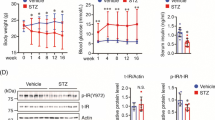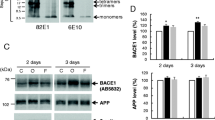Abstract
Although Alzheimer’s dementia (AD) is not characterised any longer simply as the accumulation and deposition of amyloid beta (Aβ) peptides and hyperphosphorylation of tau proteins within the brain, excessive Aβ42 deposition is still considered to play a major role in this illness. Aβ are able to adopt many differently aggregate forms, including amyloid fibrils as well as nonfibrillar structures (soluble Aβ42 oligomers). It is not well-established that which Aβ42 state is most responsible for AD or why. We wanted to verify which effects Aβ42 oligomers and aggregated peptides have on gene expression, protein level and enzyme activity of insulin and amyloid precursor protein (APP) pathways in vitro. Human neuroblastoma cells (SH-SY5Y) were treated with varying concentrations of soluble and aggregated Aβ42. Treatment effects on β-secretase (BACE), glycogen synthase kinase 3α (GSK3α), glycogen synthase kinase 3β (GSK3β), phosphatidylinositol-3 kinase (PI-3K), insulin-degrading enzyme (IDE), insulin-receptor substrate 1 (IRS1), insulin receptor (INSR) and monoamine oxidase B (MAO-B) were investigated via quantitative-PCR, western blot, ELISA and enzyme activity assay. We could find different effects of soluble and aggregated peptides especially on gene/protein expression of GSK3β and INSR and on GSK3β and MAO-B activity. Soluble peptides showed significant effects leading to increased gene expression and protein amount of GSK3β and to decreased level of gene and protein expression of INSR. MAO-B activity was enhanced after treatment with aggregated peptides and strongly inhibited after soluble Aβ42 treatment. Our data might provide insights into selective effects of specific forms of Aβ42 aggregates in AD.



Similar content being viewed by others
References
Balaraman Y, Limaye AR, Levey AI, Srinivasan S (2006) Glycogen synthase kinase 3beta and Alzheimer’s disease: pathophysiological and therapeutic significance. Cell Mol Life Sci 63:1226–1235
Barnes DE, Covinsky KE, Whitmer RA, Kuller LH, Lopez OL, Yaffe K (2010) Commentary on “Developing a national strategy to prevent dementia: Leon Thal Symposium 2009.” Dementia risk indices: a framework for identifying individuals with a high dementia risk. Alzheimers Dement 6:138–141
Bartl J, Monoranu CM, Wagner AK, Kolter J, Riederer P, Grunblatt E (2012) Alzheimer’s disease and type 2 diabetes: two diseases, one common link? World J Biol Psychiatry
Benilova I, Karran E, De Strooper B (2012) The toxic Abeta oligomer and Alzheimer’s disease: an emperor in need of clothes. Nat Neurosci 15:349–357
Biedler JL, Roffler-Tarlov S, Schachner M, Freedman LS (1978) Multiple neurotransmitter synthesis by human neuroblastoma cell lines and clones. Cancer Res 38:3751–3757
Brunet A, Datta SR, Greenberg ME (2001) Transcription-dependent and -independent control of neuronal survival by the PI3K–Akt signaling pathway. Curr Opin Neurobiol 11:297–305
Crouch PJ, Harding SM, White AR, Camakaris J, Bush AI, Masters CL (2008) Mechanisms of A beta mediated neurodegeneration in Alzheimer’s disease. Int J Biochem Cell Biol 40:181–198
Dahlgren KN, Manelli AM, Stine WB Jr, Baker LK, Krafft GA, LaDu MJ (2002) Oligomeric and fibrillar species of amyloid-beta peptides differentially affect neuronal viability. J Biol Chem 277:32046–32053
De Felice FG, Wu D, Lambert MP, Fernandez SJ, Velasco PT, Lacor PN, Bigio EH, Jerecic J, Acton PJ, Shughrue PJ, Chen-Dodson E, Kinney GG, Klein WL (2008) Alzheimer’s disease-type neuronal tau hyperphosphorylation induced by A beta oligomers. Neurobiol Aging 29:1334–1347
de la Monte SM, Longato L, Tong M, Wands JR (2009) Insulin resistance and neurodegeneration: roles of obesity, type 2 diabetes mellitus and non-alcoholic steatohepatitis. Curr Opin Investig Drugs 10:1049–1060
Ghosh AK, Brindisi M, Tang J (2011) Developing beta-secretase inhibitors for treatment of Alzheimer’s disease. J Neurochem 120(Suppl 1):71–83
Glabe CG (2008) Structural classification of toxic amyloid oligomers. J Biol Chem 283:29639–29643
Gotz ME, Fischer P, Gsell W, Riederer P, Streifler M, Simanyi M, Muller F, Danielczyk W (1998) Platelet monoamine oxidase B activity in dementia: a 4-year follow-up. Dement Geriatr Cogn Disord 9:74–77
Grünblatt E et al (2005) Oxidative stress related markers in the “VITA” and the centenarian projects. Neurobiol Aging 26:429–438
Grünblatt E, Bartl J, Riederer P (2010) The link between iron, metabolic syndrome, and Alzheimer’s disease. J Neural Transm 118:371–379
Haass C, Selkoe DJ (2007) Soluble protein oligomers in neurodegeneration: lessons from the Alzheimer’s amyloid beta-peptide. Nat Rev Mol Cell Biol 8:101–112
Hernandez F, Avila J (2008) The role of glycogen synthase kinase 3 in the early stages of Alzheimers’ disease. FEBS Lett 582:3848–3854
Hooper C, Killick R, Lovestone S (2008) The GSK3 hypothesis of Alzheimer’s disease. J Neurochem 104:1433–1439
Hoyer S, Muller D, Plaschke K (1994) Desensitization of brain insulin receptor. Effect on glucose/energy and related metabolism. J Neural Transm Suppl 44:259–268
Isik AT (2010) Late onset Alzheimer’s disease in older people. Clin Interv Aging 5:307–311
Jolivalt CG, Lee CA, Beiswenger KK, Smith JL, Orlov M, Torrance MA, Masliah E (2008) Defective insulin signaling pathway and increased glycogen synthase kinase-3 activity in the brain of diabetic mice: parallels with Alzheimer’s disease and correction by insulin. J Neurosci Res 86:3265–3274
Klyubin I, Betts V, Welzel AT, Blennow K, Zetterberg H, Wallin A, Lemere CA, Cullen WK, Peng Y, Wisniewski T, Selkoe DJ, Anwyl R, Walsh DM, Rowan MJ (2008) Amyloid beta protein dimer-containing human CSF disrupts synaptic plasticity: prevention by systemic passive immunization. J Neurosci 28:4231–4237
Lesne S, Gabriel C, Nelson DA, White E, Mackenzie ET, Vivien D, Buisson A (2005) Akt-dependent expression of NAIP-1 protects neurons against amyloid-{beta} toxicity. J Biol Chem 280:24941–24947
Mucke L, Selkoe DJ (2012) Neurotoxicity of amyloid β-protein: synaptic and network dysfunction. Cold Spring Harb Perspect Med. doi:10.1101/cshperspect.a006338
Mukherjee A, Song E, Kihiko-Ehmann M, Goodman JP Jr, Pyrek JS, Estus S, Hersh LB (2000) Insulysin hydrolyzes amyloid beta peptides to products that are neither neurotoxic nor deposit on amyloid plaques. J Neurosci 20:8745–8749
Muller UC, Zheng H (2012) Physiological functions of APP family proteins. Cold Spring Harb Perspect Med 2:a006288
Munch G, Schinzel R, Loske C, Wong A, Durany N, Li JJ, Vlassara H, Smith MA, Perry G, Riederer P (1998) Alzheimer’s disease—synergistic effects of glucose deficit, oxidative stress and advanced glycation endproducts. J Neural Transm 105:439–461
Riederer P, Danielczyk W, Grunblatt E (2004) Monoamine oxidase-B inhibition in Alzheimer’s disease. Neurotoxicology 25:271–277
Riederer P, Bartl J, Laux G, Grunblatt E (2010) Diabetes type II: a risk factor for depression-Parkinson–Alzheimer? Neurotox Res 19:253–265
Ross RA, Spengler BA, Biedler JL (1983) Coordinate morphological and biochemical interconversion of human neuroblastoma cells. J Natl Cancer Inst 71:741–747
Saura J, Andres N, Andrade C, Ojuel J, Eriksson K, Mahy N (1997) Biphasic and region-specific MAO-B response to aging in normal human brain. Neurobiol Aging 18:497–507
Schindowski K, Belarbi K, Buee L (2008) Neurotrophic factors in Alzheimer’s disease: role of axonal transport. Genes Brain Behav 7(Suppl 1):43–56
Sebollela A, Freitas-Correa L, Oliveira FF, Paula-Lima AC, Saraiva LM, Martins SM, Mota LD, Torres C, Alves-Leon S, de Souza JM, Carraro DM, Brentani H, De Felice FG, Ferreira ST (2012) Amyloid-beta oligomers induce differential gene expression in adult human brain slices. J Biol Chem 287:7436–7445
Small DH (2004) Mechanisms of synaptic homeostasis in Alzheimer’s disease. Curr Alzheimer Res 1:27–32
Townsend M, Mehta T, Selkoe DJ (2007) Soluble Abeta inhibits specific signal transduction cascades common to the insulin receptor pathway. J Biol Chem 282:33305–33312
Vandesompele J, De Preter K, Pattyn F, Poppe B, Van Roy N, De Paepe A, Speleman F (2002) Accurate normalization of real-time quantitative RT-PCR data by geometric averaging of multiple internal control genes. Genome Biol 3:RESEARCH0034
Wang DS, Dickson DW, Malter JS (2008) Tissue transglutaminase, protein cross-linking and Alzheimer’s disease: review and views. Int J Clin Exp Pathol 1:5–18
Zhang Y, Hong Y, Bounhar Y, Blacker M, Roucou X, Tounekti O, Vereker E, Bowers WJ, Federoff HJ, Goodyer CG, LeBlanc A (2003) p75 neurotrophin receptor protects primary cultures of human neurons against extracellular amyloid beta peptide cytotoxicity. J Neurosci 23:7385–7394
Zhao WQ, Lacor PN, Chen H, Lambert MP, Quon MJ, Krafft GA, Klein WL (2009) Insulin receptor dysfunction impairs cellular clearance of neurotoxic oligomeric a{beta}. J Biol Chem 284:18742–18753
Acknowledgments
Funding for this study was partially provided by the “Alzheimer Forschungs Initiative (AFI)”, Düsseldorf, Germany; the AFI had no further role in study design; in the collection, analysis and interpretation of data; in the writing of the report and in the decision to submit the paper for publication. We thank Miryame Hofmann for her excellent technical assistance and also Dr. Zoya Marinova for her great and excellent support.
Author information
Authors and Affiliations
Corresponding author
Electronic supplementary material
Below is the link to the electronic supplementary material.
Rights and permissions
About this article
Cite this article
Bartl, J., Meyer, A., Brendler, S. et al. Different effects of soluble and aggregated amyloid β42 on gene/protein expression and enzyme activity involved in insulin and APP pathways. J Neural Transm 120, 113–120 (2013). https://doi.org/10.1007/s00702-012-0852-5
Received:
Accepted:
Published:
Issue Date:
DOI: https://doi.org/10.1007/s00702-012-0852-5




